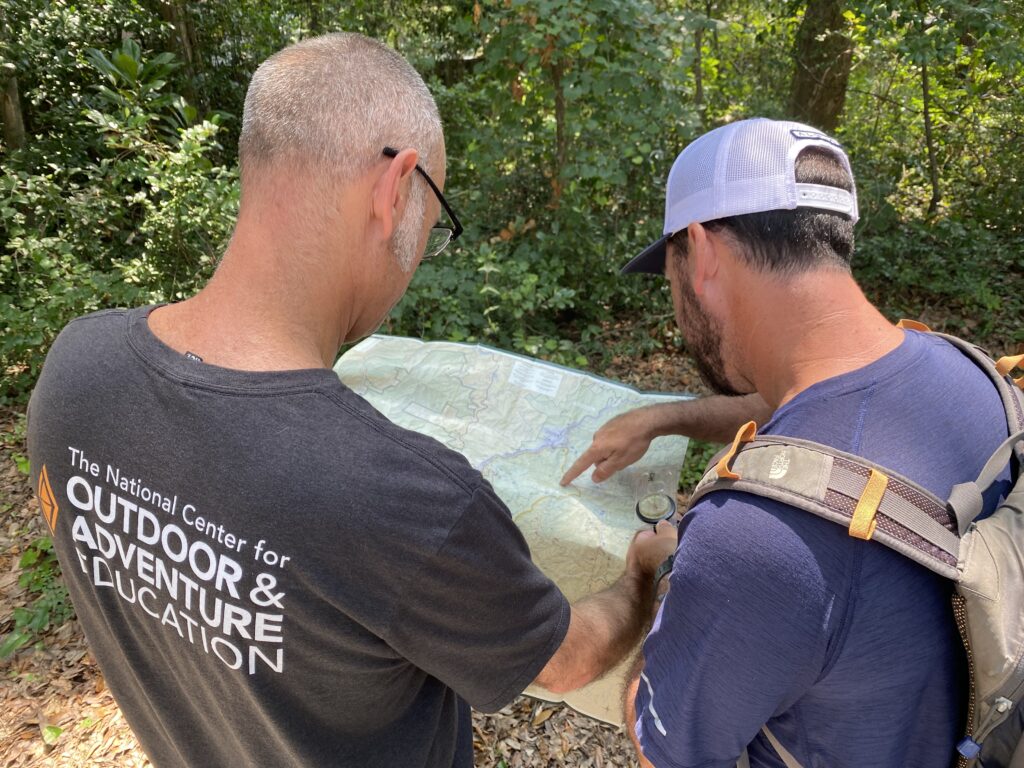Why Learn Map and Compass Skills in the Age of GPS and Digital Tools?
June 28, 2023
Undoubtedly, you’re either reading this on a smartphone or you’ve got a smartphone in your pocket or sitting on the table or desk in front of you. Most likely, that device features a compass. In fact, the digital app version of one of the most ancient navigational tools in the world comes standard with most cell phones and other mobile devices these days.
Toss in Google Maps, Pacer, Apple Maps, MapMyWalk, Waze, and other directional apps that rely on GPS technology and you’ve got to ask yourself, “Why the heck should I bother using unwieldy paper maps and a handheld compass to explore the backcountry?”

Of course, there are plenty of good reasons to master traditional map and compass skills, the most obvious being, “Damn, I got no signal.”
Here at The National Center for Outdoor and Adventure Education (NCOAE), we include lessons in basic map and compass skills on every expedition we lead. In fact, it’s part of our “First 48” programming, which teaches students important technical skills they’ll need to know within the first two days of any NCOAE backcountry expedition.
During the Fist 48, NCOAE course participants learn the basics of a baseplate compass, as well as how to read a topographic map. Then they use them in concert to determine where they are and how to follow the route to their next campsite. On longer expeditions, we instruct how to shoot a bearing to an off-trail location and ultimately, to triangulate their position using two visible landmarks.
Of course, our field instructors carry satellite communication devices for emergency use, and these also have GPS mapping capabilities, but we choose to use traditional map and compass skills for navigation. One reason is that — given Murphy’s Law — electronics will generally fail when you need them most. And while maps might not easily fold back up correctly, they remain a steadfast, simple, and reliable tool for use in the backcountry.
Electronic devices require batteries, which limits their reliability in a wilderness environment. If you dedicate yourself to using map and compass, you save your battery power for emergencies as opposed to daily navigation.
In addition, GPS devices generally don’t take the terrain into account. They can direct you from Point A to Point B in a straight line, but they don’t often take into consideration changes in altitude, the nature of the terrain, or factors such as river crossings or steep canyon walls that might make the route unfit for travel.
Aside from the safety limitations of relying only on electronic devices in the backcountry, there’s also the value of having a good understanding where you are in the world, and the ability to generate a solid internal picture and spatial understanding of the area in which you find yourself.
In a 2008 study, Smithsonian Magazine noted, “people who used a GPS to navigate a city developed a shakier grasp of the terrain than those who consulted a paper map or those who learned the route via direct experience.” While not as attention grabbing as the stories of people who blindly followed the GPS system in their cars down a boat ramp and into the water, or onto busy pedestrian walkways, it’s clear that strict reliance on GPS technology causes people to be less aware of where they are. Perhaps just as important, it impedes the development of the user’s sense of direction.
Our current digital navigational tools are certainly valuable and helpful, and almost always within arm’s length of those with smartphones. However, we shouldn’t forget the value, simplicity, and consistency of the map and compass. These are tools that have been used for thousands of years, so we shouldn’t discount the advances made in their accuracy and usefulness.
Learning and practicing navigation with map and compass provides one with a sense of independence and confidence, knowing that we can travel in the world without fear of getting lost, and without being dependent on technology and limited battery power.
= = = = = = = = = =
About the Author: Cameron “Cam” Francisco, MEd, is the Associate Director of Outdoor Education at The National Center for Outdoor & Adventure Education (NCOAE). Prior to joining the team at NCOAE, Cam spent 19 years as an independent school educator and administrator. A member of the Association for Experiential Education (AEE), Cam is a certified Wilderness First Responder (WFR) and is certified in CPR by the Red Cross. His hobbies include fishing, soccer, skateboarding, hiking, and camping.
TALK TO US
Have any further questions about our courses, what you’ll learn, or what else to expect? Contact us, we’re here to help!
Leave a comment